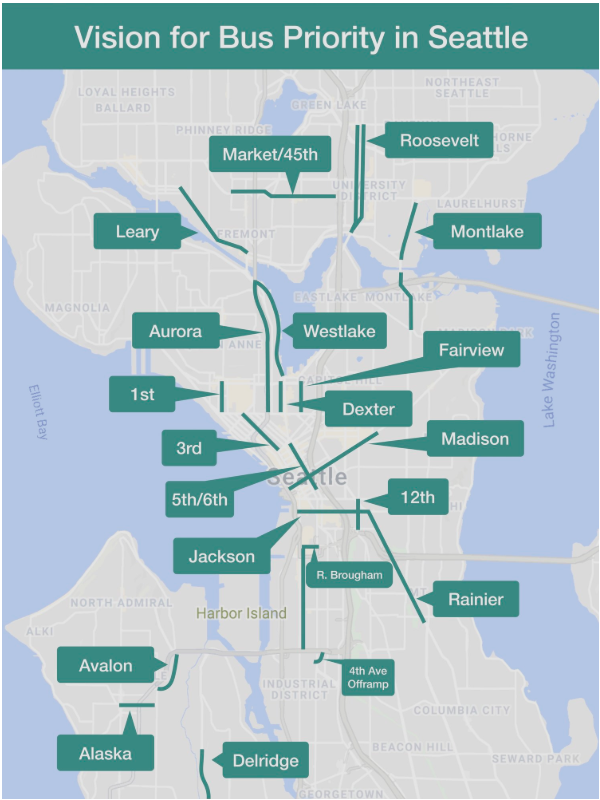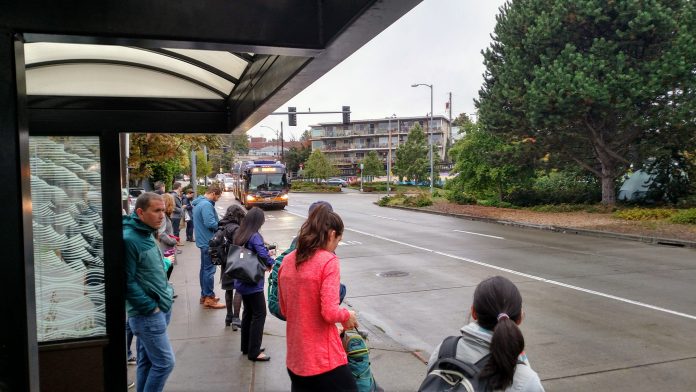On Thursday, officials from the City of Seattle, Washington State Department of Transportation, and King County Metro held a joint press conference to discuss upcoming traffic impact responses that agencies will make in the wake of imminent closure of the SR-99 viaduct and long-term mega-construction projects happening in Downtown Seattle through 2024.
“I think the more people know and understand about what and how difficult it is going to be to get in and around Seattle, the better it will be,” Mayor Jenny Durkan said. “What we’ve been doing [is] to make sure there are other ways than cars to do that. Our office and the City of Seattle has made preparing for this period a priority.”
The first impacts from the closure of the SR-99 viaduct will begin on January 4th with the southbound S Atlantic St off-ramp and northbound Royal Brougham Way on-ramp. Other on- and off-ramps as well as the highway mainline will remain open until 10pm on January 11th when the remainder of the viaduct will fully closes.

The Washington State Department of Transportation (WSDOT) expects that the full viaduct closure will send an estimated 90,000 daily vehicle trips to other roads or convert to other types of trips until the new deep-bore tunnel opens in February. The theory of induced demand also predicts some trips will disappear without a giant downtown highway viaduct making them so enticing and convenient, and agencies are emphasizing working from home on their websites and press releases. During the viaduct closure, WSDOT is planning to convert I-5 southbound high occupancy vehicle (HOV) lanes to general purpose lanes from Mercer Street to Corson Ave S just for good measure–keeping motorists happy and suffering in equal measure while ensuring transit is exceptionally slow on I-5.
But even after the “Seattle Squeeze” wraps up, other long-term impacts from large construction projects and lack of city center exits from the tunnel will still prevail making travel through downtown challenging at least through 2024.
The Seattle Department of Transportation (SDOT) will roll out temporary transit lanes on Cherry Street, 4th Ave S, Aurora Avenue, and the West Seattle Bridge ahead of the viaduct closure. Though slated to be temporary, they may become permanent. “The last time we closed the viaduct and added some of these things, they actually work really well,” said Heather Marx, SDOT Director of Downtown Mobility. “Some of these may become permanent depending upon the operational needs.”

Last week, the Move All Seattle Sustainably (MASS) coalition laid out a plan to deploy more bus lanes across the city now to keep buses moving during the Seattle Squeeze and long-term Period of Maximum Constraint. The planned corridors by SDOT are similar to a few MASS proposed bus lanes, an indication perhaps that MASS is influencing city officials to take bolder action.
The transit and freight bypass over SR-99 between Alaskan Way S and Colorado Ave S in Pioneer Square–notable for its “h” shape–will open, making it easier for buses to get around. However, the eastbound contraflow lane on Seneca Street for buses will be removed since the viaduct off-ramp to it will permanently close.
Mayor Jenny Durkan acknowledged the frustration with people driving blocking transit and bike lanes. “Normal traffic enforcement can’t help that much because we have a police officer pulling someone over,” Mayor Durkan said. “It just blocks traffic more. So we are seeking in Olympia, with the County, the authority to use camera enforcement for our bike lanes and bus lanes… so that we can keep those things flowing bikes, pedestrians, and transit.”

Marx said the recent expansion of transit priority hours to seven days a week on Third Avenue should help and issued a warning to motorists. “Really don’t drive on Third Avenue,” she said. In March, Third Avenue will have all-door boarding as the next phase of speed and reliability for buses on the corridor. As an interim solution due to the delayed deployment of additional ORCA card readers at most Third Avenue stops, Metro will have staff members with hand-held ORCA readers to facilitate all-door boarding. MASS has also called on the City to extend Third Avenue transit priority and restrictions through Belltown (currently they terminate at Stewart Street) to get buses to Denny Way and beyond unimpeded, but the City has taken a wait-and-see approach.
Starting on January 14th, the King County Water Taxi between West Seattle and the Colman Ferry Dock will see service double (an extra 12 trips), offering 20-minute headways at peak. This will help provide extra service on weekdays, particularly during the midday. King County Metro will operate shuttle Routes 773 and 775 in West Seattle to meet all extra sailings at the Seacrest Park Ferry Dock. The extra service is planned to operate through March 27th after which Metro will revert to a summer sailing scheduled. But perhaps if ridership is robust enough, the transit agency will find a way to continue extra water taxi trips permanently.
“It’s important for people to realize that [bus] routes coming into Downtown Seattle from everywhere will be less predictable and will most likely be delayed to some extent,” said Bill Bryant, service planner for Metro.

Bryant highlighted several bus routes from the north end that will be particularly impacted due to their usage of Aurora Avenue. Metro expects service disruptions to Routes 5, 5X, 26, and 28 as well as the RapidRide E Line in both directions during the viaduct closure, at least until the new tunnel opens. Southbound routes on Aurora Avenue may need to rerouted. “We’re going to take a dynamic approach to this situation,” Byrant said. “Where Metro will be more flexible than we ever have been before in rerouting in real time to respond to changing conditions.”
Metro will have up to 20 extra buses ready on standby for deployment seven days a week all day long, at least until the early evening. Weekends may have fewer extra buses available. “Those buses will be able to fill in on any route in the system that’s affected by this traffic situation,” Bryant said.

On the south end of Downtown Seattle, Metro will have several key pathways for buses to use during and after the viaduct closure. Express and express-like buses to points south like West Seattle and Burien will typically operate on the yellow path, as indicated in the map, but may use an alternate path, indicated in orange, during the initial viaduct closure if traffic is an obstacle. Once the new SR-99 tunnel opens, buses will primarily use the blue path indicated below until the permanent pathway, indicated in green is a viable option. This should not affect where riders get on and off buses, Bryant said. Affected routes will include Routes 21X, 37, 55, 56, 57, 113, 120, 121, 122, 123, and 125 as well as the RapidRide C Line.
If the initial response is not sufficient, SDOT could deploy further temporary transit-only lanes to keep buses moving, Marx said. Transit restrictions and transit priority could also be expanded to include hours between 5am and 10pm. MASS, on the other hand, is pushing the City to be more proactive rather than wait for transit gridlock to ensue.

On March 23rd, remaining buses in the Downtown Seattle Transit Tunnel will move entirely to surface streets. The tradeoff here is less reliability and speed for people taking Routes 41, 74, 101, 102, 150, 255, and 550 but faster and more reliable Link trains remaining in the tunnel. A new transit path will be rolled out on Fifth Avenue and Sixth Avenue for many surface bus routes.
Whether we call it the Seattle Squeeze or the Period of Maximum Constraint or Carmaggedon, it will undoubtedly be a challenging time to get around the city. But it does present a lot of opportunity to promote, invest, and make deep prioritization changes for transit in order to keep Seattle and the region moving.
Correction: At the time of publishing, we inadvertently specified the I-90 HOV lanes instead of I-5 HOV lanes that will be open to all traffic in the southbound direction.
Stephen is a professional urban planner in Puget Sound with a passion for sustainable, livable, and diverse cities. He is especially interested in how policies, regulations, and programs can promote positive outcomes for communities. With stints in great cities like Bellingham and Cork, Stephen currently lives in Seattle. He primarily covers land use and transportation issues and has been with The Urbanist since 2014.


